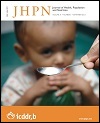Food Insecurity and Its Sociodemographic Correlates among Afghan Immigrants in Iran
DOI:
https://doi.org/10.3329/jhpn.v31i3.16828Keywords:
Afghan, Immigrants, Food insecurity, Sociodemographic determinants, IranAbstract
The study determined the prevalence of food insecurity and its sociodemographic determinants among Afghan immigrants in two major cities of Iran. This cross-sectional study was conducted on a sample of 310 adult females from immigrant Afghan households in Tehran (n=155) and Mashhad (n=155), who were recruited through multistage sampling. Data were collected through face-to-face interviews, using a questionnaire. Food security was measured by a locally-adapted Household Food Insecurity Access Scale. More than 60% suffered from moderate-to-severe food insecurity, 37% were mildly food-insecure while about 23% were food-secure. Food insecurity was significantly more prevalent in female-headed households, households whose head and spouse had lower level of education, belonged to the Sunni sect, and those with illegal residential status, unemployment/low job status, not owning their house, low socioeconomic status (SES), and living in Mashhad. Prevalence of food insecurity was relatively high among Afghan immigrants in Iran. This calls for the need to develop community food security strategies for ensuring their short- and long-term health.
DOI: http://dx.doi.org/10.3329/jhpn.v31i3.16828
J HEALTH POPUL NUTR 2013 Sep; 31(3): 356-366
Downloads
451
279

